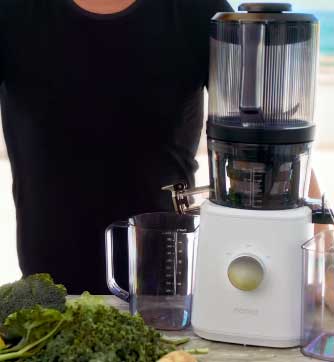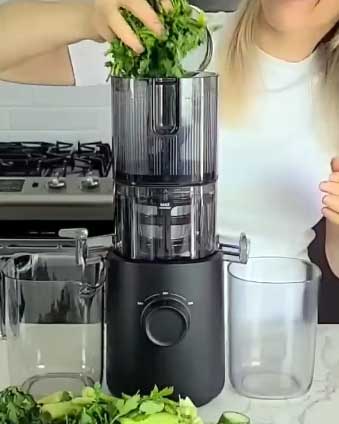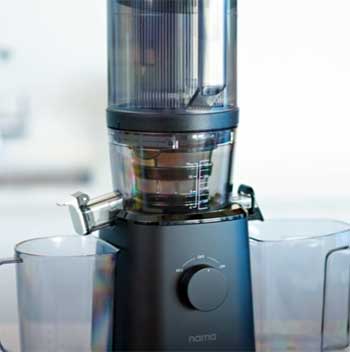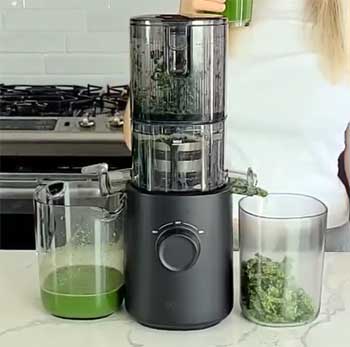I’m no stranger to juicing, and when it comes to picking the right machine, the Nama J2 and J3 are two heavyweights worth considering. As someone who’s spent mornings wrestling with celery stalks and afternoons sipping vibrant concoctions, I’m here to break down these juicers for you.
My goal?
To help you decide which one fits your kitchen, lifestyle, and juice obsession by comparing their features, weighing their pros and cons, and sharing my real-world experience. Let’s get squeezing and figure out which Nama juicer deserves your counter space.
A Brief Comparison Table
| Feature | Nama J2 | Nama J3 |
| Hopper Volume | 70 oz | 34 oz |
| Chamber Volume | 16 oz | 12 oz |
| Juice Yield | 16–32 oz | 8–16 oz |
| Dimensions | 9.8″ W x 9.0″ D x 17.7″ H | 8.5″ W x 8.1″ D x 16.3″ H |
| Weight | 12.1 lbs | 10.3 lbs |
| Motor Power | 200 watts | 150 watts |
| Speed | 43 RPM | 43 RPM |
| Noise Level | Moderate | Quieter |
| Price (Approx.) | $550 | $399 |
| Best For | Batch juicing, larger households | Small spaces, single servings |
This table gives you a quick snapshot, but there’s more to these machines than numbers. Let’s unpack what makes each juicer tick and why you might lean one way or the other.
Why I’m Comparing These Juicers?
Juicing isn’t just a trend for me—it’s a ritual. Whether I’m blending greens for a health kick or experimenting with pineapple and ginger, a good juicer is my kitchen sidekick. Nama’s J2 and J3 caught my eye because they’re cold-press champs, promising high yields and nutrient-packed juice.
But they’re not twins; each has its own personality. I’ve used both, cleaned their parts, and tasted their output. My mission is to share what I’ve learned so you can pick the one that vibes with your juicing goals.
Key Features of The Nama J2
The Nama J2 is like the workhorse of juicers. It’s built for people who juice in bulk or want to prep a week’s worth of green goodness in one go. Here’s what stands out:

- Large Hopper Capacity: With a 70-ounce hopper, the J2 lets me toss in whole apples, carrots, or a pile of kale without constant chopping. It’s a time-saver when I’m juicing for my family or meal-prepping. The “hands-free” design means I can load it up, turn it on, and walk away to tackle other tasks.
- High Juice Yield: The J2’s 16–32-ounce yield per session is impressive. I’ve juiced everything from soft oranges to tough beets, and it squeezes out every last drop. Less pulp means more juice, which feels like a win for my wallet and my taste buds.
- Versatile Strainers: It comes with three strainers: one for juice, one for smoothies, and one for sorbet. I’ve whipped up creamy mango sorbets and thick green smoothies, which adds variety to my routine. The sorbet strainer is a game-changer for dessert nights.
- Sturdy Build: At 12.1 pounds, the J2 feels solid. Its sleek, modern design doesn’t scream “bulky appliance,” but it’s not exactly lightweight. I’ve moved it around my counter without issue, though it’s best parked in one spot if you juice daily.
- Easy Cleaning: Cleaning juicers can be a chore, but the J2’s parts rinse off quickly. The pulp container and strainers need a good scrub, but I’ve got it down to five minutes with a brush and warm water. Pro tip: rinse right after juicing to avoid sticky buildup.
Key Features of The Nama J3
The Nama J3 is the J2’s compact cousin, designed for smaller spaces and lighter juicing needs. It’s nimble but still packs a punch. Here’s what I noticed:

- Compact Size: At 8.5 inches wide and 10.3 pounds, the J3 is perfect for my tiny apartment days. It fits snugly on a crowded counter or tucks into a cabinet. If you’re in a dorm, RV, or small kitchen, this juicer’s size is a lifesaver.
- Single-Serve Focus: The 34-ounce hopper and 12-ounce chamber are ideal for one or two servings. I love throwing in a quick mix of cucumber, lemon, and mint for a solo refresh. It’s less about batch juicing and more about fresh, on-demand sips.
- Quieter Operation: The J3’s 150-watt motor hums softer than the J2. I’ve juiced early mornings without waking my partner, which is a big plus. It’s not silent, but it’s less intrusive than most juicers I’ve tried.
- Same Slow Speed: Like the J2, the J3 runs at 43 RPM, preserving nutrients through cold-press magic. I’ve noticed no difference in juice quality between the two—both deliver vibrant, froth-free juice that lasts up to 72 hours in the fridge.
- Budget-Friendly Price: At around $399, the J3 is easier on the bank account than the J2’s $550. For casual juicers or those dipping their toes into cold-press, this price point feels more approachable.
Pros And Cons of The Nama J2
Every juicer has its highs and lows. Here’s my take on the J2 after months of use:
Pros
- Batch Juicing Beast: The 70-ounce hopper means I can juice a pitcher’s worth in one go. Perfect for families or weekly preppers like me.
- Max Juice, Min Waste: I get more juice from less produce, saving money over time. A single beetroot yields a surprising amount.
- Multi-Purpose: The smoothie and sorbet strainers let me mix things up. My kids love the sorbet, and I’m hooked on thick breakfast blends.
- Durable Design: It’s built to last. I’ve dropped the pulp container (oops), and it’s still intact.
- Nutrient Retention: The slow 43 RPM keeps enzymes and vitamins alive, which is why I started juicing in the first place.
Cons
- Pricey Investment: At $550, it’s a splurge. I had to save up, and it might not suit everyone’s budget.
- Counter Hog: It’s not huge, but it needs space. My small kitchen felt cramped until I reorganized.
- Slightly Noisier: Compared to the J3, it’s a bit louder. Not a dealbreaker, but noticeable in quiet moments.
- Heavier Weight: At 12.1 pounds, moving it daily isn’t fun. I’ve left it on my counter permanently.
Pros And Cons of The Nama J3
The J3 is a different vibe, with its own strengths and quirks. Here’s the breakdown:
Pros
- Space-Saver: Its compact size is a dream for small kitchens. I’ve used it in tight spaces without stress.
- Affordable: At $399, it’s a solid entry into cold-press juicing without breaking the bank.
- Whisper-Quiet: The quieter motor makes morning juicing peaceful. No grumpy roommates here.
- Quick Cleanup: Fewer parts and a smaller chamber mean cleaning is a breeze. I’m done in under five minutes.
- Portable: At 10.3 pounds, I’ve taken it to a friend’s place for a juice party. Try that with bulkier models.
Cons
- Smaller Yield: The 8–16-ounce output is fine for one person but limiting for families or batch juicing.
- Less Versatile: No smoothie or sorbet strainers. It’s juice-only, which might disappoint variety seekers.
- Smaller Hopper: The 34-ounce hopper requires more prep and frequent refills. Chopping produce is a must.
- Weaker Motor: The 150-watt motor struggles slightly with hard veggies like carrots compared to the J2.
Key Comparison of Nama J2 And J3
To help you choose, I’ve broken down the key factors that set the Nama J2 and J3 apart. Here’s how they stack up, based on my hands-on time with both.

- Hopper and Chamber Capacity: The J2’s 70-ounce hopper and 16-ounce chamber dwarf the J3’s 34-ounce hopper and 12-ounce chamber. With the J2, I can load up whole fruits and veggies, like apples or cucumbers, and juice a 32-ounce pitcher in one go—perfect for my family’s weekly prep. The J3, however, requires more chopping and refilling for larger batches, capping out at 16 ounces. If you’re juicing for one or two, the J3’s smaller capacity is plenty, but for households or meal-preppers, the J2’s volume wins.
- Juice Yield: The J2’s yield ranges from 16–32 ounces per session, while the J3 delivers 8–16 ounces. I’ve noticed the J2 extracts more from tough produce like beets or carrots, leaving drier pulp. The J3 matches it for juice quality—vibrant and nutrient-rich—but its smaller chamber limits output. For daily single servings, the J3 is fine, but the J2’s higher yield saves produce and time for bulk juicing.
- Size and Weight: The J2 measures 9.8″ W x 9.0″ D x 17.7″ H and weighs 12.1 pounds, while the J3 is smaller at 8.5″ W x 8.1″ D x 16.3″ H and 10.3 pounds. In my cramped apartment, the J3 was a countertop dream, fitting next to my coffee maker. The J2, however, demanded a dedicated spot, which was tricky in smaller kitchens. If space is tight, the J3’s compact design and lighter weight make it easier to store or move.
- Motor Power: The J2’s 200-watt motor outperforms the J3’s 150-watt motor, especially with hard vegetables. I’ve juiced carrots and ginger with both, and the J2 powers through faster with less strain. The J3 handles soft fruits like oranges well but slows slightly with tougher produce. Both maintain a 43 RPM speed for nutrient retention, so juice quality is identical, but the J2’s extra power suits heavy juicing sessions.
- Noise Level: The J3 is noticeably quieter than the J2. When I juiced early mornings with the J3, it hummed softly, letting my partner sleep. The J2’s moderate hum isn’t loud enough to wake the house but can disrupt a quiet kitchen. If noise is a concern—say, in a shared space—the J3 has the edge.
- Versatility: The J2 includes three strainers (juice, smoothie, sorbet), letting me make everything from green juice to mango sorbet. The J3 sticks to juicing only, with no extra strainers. I missed the J2’s smoothie option when using the J3, especially for breakfast blends. If you want variety beyond juice, the J2 is the clear winner.
- Price: At $550, the J2 is a bigger investment than the J3’s $399. The J2’s price reflects its larger capacity and versatility, but it’s a stretch for casual juicers. The J3’s lower cost makes it accessible for beginners or those juicing occasionally. I justified the J2’s cost for frequent use, but the J3 felt like better value for lighter needs.
- Cleaning: Both juicers clean easily, but the J3’s smaller parts make it slightly faster—about four minutes versus the J2’s five. The J2’s larger pulp container needs more scrubbing, especially after batch juicing. Rinse either immediately after use, and you’re golden.
- Best Use Case: The J2 excels for families, batch juicers, or those wanting versatility. The J3 suits solo juicers, small kitchens, or budget-conscious buyers. I leaned on the J2 for weekly prep, but the J3 was my go-to in a tiny apartment for quick, fresh juices.
My Time with The J2
When I first unboxed the Nama J2, I was struck by its sleek look—like a modern sculpture for my kitchen. Setting it up was straightforward, though the manual helped with the strainers. My first juice was a classic: celery, apple, and ginger.
I loaded the hopper, hit start, and watched it work its magic. The juice was crisp, with no gritty pulp, and the yield filled two mason jars. Cleanup took a bit longer than I’d hoped, but I got faster with practice.
Batch juicing is where the J2 shines. On Sundays, I’ll spend 30 minutes prepping a week’s worth of juice—kale, cucumber, lemon, and turmeric. The hopper handles it all, and I’m left with vibrant juice that stays fresh for days.
The sorbet strainer was a surprise hit; my mango-banana blend rivaled store-bought treats. But the price tag? It stung. I justified it by cutting back on coffee shop runs, but it’s not a casual purchase.
The noise is noticeable. It’s not a blender-level roar, but it’s louder than my kettle. If you’re juicing at dawn, earplugs might be your friend. And while I love the yield, the J2’s size means I had to rethink my counter layout.
It’s a commitment, but for a juice fanatic like me, it’s worth it.
My Time With The J3

The Nama J3 joined my kitchen when I downsized to a smaller apartment.
Its compact footprint was a relief—no more Tetris with appliances. Setup was a snap, and I was juicing within minutes.
My go-to is a quick cucumber-mint blend, perfect for one glass.
The juice quality matches the J2’s—bright, smooth, and nutrient-dense.
The quieter motor was a blessing in my open-plan space; I could juice while my partner slept.
The J3’s single-serve focus suits my solo lifestyle. I don’t need gallons of juice, so the 12-ounce chamber is plenty. But when I tried juicing for a friend, the smaller hopper meant more chopping and refilling.
It’s not built for big batches, and the lack of smoothie or sorbet options felt limiting after the J2’s versatility. Hard veggies like beets took longer, and I could feel the motor working harder than the J2’s.
Cleaning is a dream, though. I rinse the parts under the tap, and I’m done before my juice is chilled. The price felt more reasonable, especially since I wasn’t juicing daily. If you’re new to juicing or short on space, the J3 is a friendly starting point.
Which Juicer Wins For Me?
Picking between the J2 and J3 depends on your life. The J2 is my go-to for its versatility and output. I juice often, and the ability to prep a week’s worth in one session saves me time. The sorbet and smoothie options keep things fun, and the yield stretches my grocery budget.
But it’s pricey, and its size demands counter real estate.
If you’re juicing for one or two people and value space and affordability, the J3 is a gem. Its quiet motor and easy cleanup make it a low-maintenance pal, though it’s not cut out for big batches or variety.
I’ve leaned on the J2 because my household drinks juice like water, but I loved the J3’s simplicity when I lived alone. Neither is perfect, but both deliver stellar juice. Your choice hinges on how much you juice, where you’ll store it, and what you’re willing to spend.
Frequently Asked Questions (FAQ)
The J2 has a larger 70-ounce hopper and 16–32-ounce yield, ideal for batch juicing, while the J3’s 34-ounce hopper and 8–16-ounce yield suit single servings. The J3 is smaller, quieter, and cheaper ($399 vs. $550).
The Nama J3 already exists and is available for purchase. It’s a compact cold-press juicer designed for smaller spaces.
For frequent juicers or families, the J2’s high yield and versatility justify its $550 price. If you juice occasionally, the J3 might be enough.
Yes, with the sorbet strainer, the J2 handles frozen fruit for sorbets or desserts. Thaw slightly for best results.
Conclusion: Your Juice, Your Choice
You’ve got the full scoop on the Nama J2 and J3, and now it’s up to you to pick your juicing partner. I’ve shared my mornings with both, from the J2’s batch-jucing marathons to the J3’s quick solo sips. Whether you’re dreaming of a fridge stocked with green juice or just want a fresh glass now and then, these machines deliver.
Think about your space, budget, and juicing habits. You can’t go wrong with either, but one will feel just right. So, grab your produce, choose your Nama, and start juicing—you’ll thank yourself with every vibrant sip.
